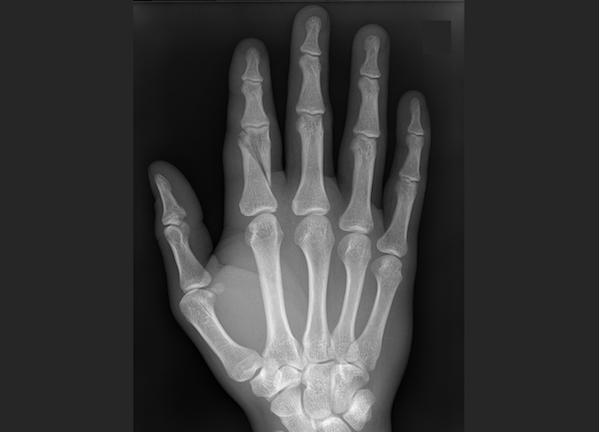A finger fracture might seem like a small and insignificant injury, but its impact on your daily life can be surprisingly disruptive, even a single injured finger can limit your range of motion and grip. Daily tasks such as writing and cooking, driving, and even getting dressed, are something which we all take for granted, and yet can become suddenly challenging after fracturing your finger.
In this blog, we will discuss the healing process, factors that affect recovery, and tips for a smooth rehabilitation.
What is a finger fracture?
The finger comprises bones known as phalanges, with three of these in each finger and two in each thumb. A finger fracture occurs when one or more of these bones break.
There are three main types of finger fractures:
Avulsion fracture
An avulsion fracture is when a ligament or tendon and the bone fragment are attached to pull away from the main bone.
Impacted fracture
An impacted fracture sees the broken ends of a bone impact with each other.
Shear fracture
A shear fracture happens when the bone splits completely into two pieces, both moving in opposite directions.
Finger fractures are common as your fingers have the highest risk of injury out of any part of your hand. You can injure your fingers at work, partaking in hobbies or from accidental trips and falls to name a few. However, it is the nature of the injury and the strength of the bone that determines whether a fracture occurs. With conditions such as osteoporosis and malnutrition, your chances of breaking a finger increase.
How long does a finger fracture take to heal?
The healing time for finger fractures can vary from person to person, but on average, most fractures take around 4 to 6 weeks to heal, if properly treated. The recovery process is typically divided into three phases.
The inflammatory phase is the first 1 to 2 weeks of healing and is marked by the pain, swelling and bruising on the finger as it begins to repair. During this time, the injured area may feel tender and painful to touch as blood clots form as a barrier around the injury.
The next stage is the reparative phase, which takes place over the consecutive 2 to 4 weeks, during which the body generates callus tissue that gradually hardens into new bone. This stage is critical to the healing process as, at this stage, the fracture starts to fuse back together, although the bone remains vulnerable to further injury.
Finally, the remodelling phase begins around the 4-week mark and onwards. This part of the healing process involves the strengthening and shaping of new bone. During this stage, the bone is refined to restore its original shape and functionality.
Are there any factors that will affect this healing time?
As mentioned previously, healing times will vary, based on several factors; such as the type of fracture, where it is located and the severity of the break. Additionally, age plays a significant role in this process. Children and young adults often recover faster, due to their body’s enhanced regenerative abilities, while older individuals, particularly those with conditions like osteoporosis or diabetes, may experience a delay in healing. But proper care, rest and compliance with medical advice can also greatly impact a speedy recovery.
The severity of the fracture
A simple fracture, where there is a clean break in the bone and fractured parts remain aligned, generally heals faster than a complex fracture. A complex fracture may involve multiple fragments, misalignment and additional damage to the surrounding tissue.
Treatment
The types of treatment used to address the fracture will play a significant role in your recovery time. Fractures treated with splints or casts typically require less medical intervention and a shorter recovery period. In contrast, more severe fractures that require surgery, such as the insertion of pins, plates, or screws, might take longer to heal due to the complexity of the procedure.
Compliance
Patient compliance is crucial in determining the success of the healing fracture. Following medical advice, keeping your finger immobilised for the intended period, attending appointments and engaging in the correct rehabilitation, can greatly speed up recovery. Ignoring or not taking these guidelines seriously, may prolong healing or lead to further complications like stiffness or poor bone alignment.
What can I do to support the healing process?
Fractured bones won’t heal overnight, and require you to have some patience and a proactive approach. First and foremost, rest and protection is the number one priority, keeping your finger immobilised with a splint or cast helps to stabilise the bone and prevent any further injuries during early healing stages.
As your recovery progresses, physical therapy can aid in strengthening and regaining mobility to your finger. Gentle exercises tailored for you can help to rebuild functionality without straining the healing bone.
Whilst you may not be aware, nutrition is another key factor in recovery. A diet rich in calcium, vitamin D, and protein supports bone regeneration and overall tissue repair. Foods such as dairy products, leafy greens, fatty fish, nuts and lean meats can give your body the nutrients it needs to support healing bones.
When should I see medical attention?
While most finger fractures heal without issue, complications can occasionally arise, making it essential to monitor your recovery closely. One potential issue is non-union, where the bone fails to heal properly, or malunion, where the bone heals in an incorrect position, potentially causing deformity or functional limitations. Additionally, prolonged stiffness or loss of mobility in the finger can occur if rehabilitation exercises are delayed or incomplete.
It’s important to stay alert to warning signs during the healing process. Symptoms such as increased pain, swelling, redness, and warmth around the affected area, or the onset of fever, could signal an infection or other complications. Similarly, persistent discomfort or reduced range of motion after the expected healing time may indicate a problem that requires medical attention.
If you notice any of these red flags or have concerns about your progress, don’t hesitate to contact your doctor. Prompt evaluation by a healthcare professional can help address complications early and ensure your finger heals properly.
If you are concerned about a recent finger fracture book an appointment with Ladan Hajipour.




